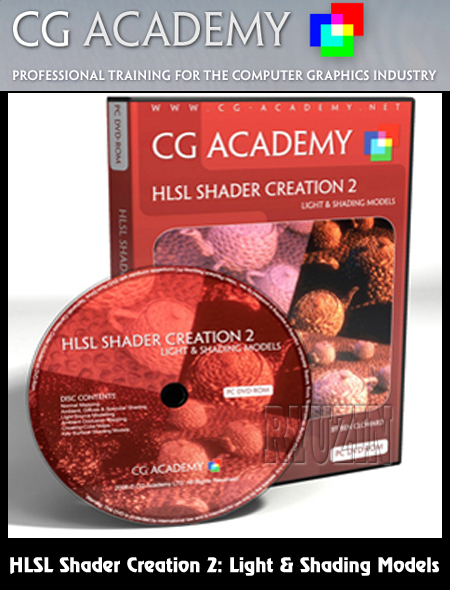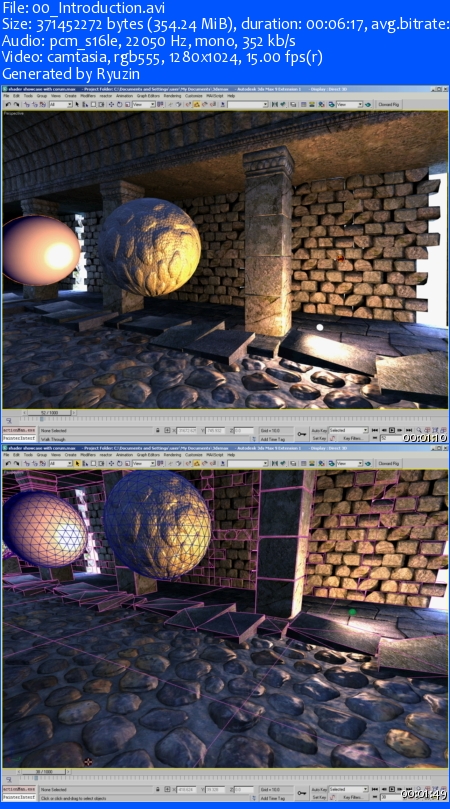
CG Academy - HLSL Shader Creation 2: Light & Shading Models
English|Instuctor: Ben Cloward| 3h 24m| .ISO| 2.46GB
Genre: Video Training
In this second DVD in our HLSL Shader Creation series, Ben Cloward explores how you can create the main building blocks of a lighting and shading system in HLSL. He shows how you can build shaders to represent the Ambient, Diffuse and Specular components of surface shading. How to enhance your Ambient shading by using a combination of convolved HDRI environment maps and baked Ambient Occlusion. Ben also shows you how to create Point, Directional and Spot light sources. And we wrap up with a practical exploration of some of today’s standard surface shading models, including Phong, Blinn, Cook/Torrence and Oren/Nayar.
This DVD builds on the theory and skills taught in DVD one in this series. You need to know how to write basic HLSL shader code (surface & light) to get the most out of this title.
CH01: Normal Mapping
Ben starts by looking at how we can use Normal Maps to add surface detail and form to our shading.
CH02: Basic Lighting - Ambient Light
We start our exploration of surface shading by modelling the non-directional Ambient lighting component.
CH03: Basic Lighting - Diffuse Light
Now we add in directional diffuse lighting into our shading model.
CH04: Basic Lighting - Specular Light
And we finish off our basic shading model with our Specular highlights.
CH05: Advanced Lighting – Light Attenuation
Now Ben looks at how we can better model our light sources. So, firstly we make our lights intensity diminish over distance, just as lights do in the real world.
CH06: Advanced Lighting – Directional Lights
Next Ben models distant light sources, such as the Sun, with directional light.
CH07: Advanced Lighting – Spot Lights
And finally Ben looks at how we can focus a light into a defined circular throw, with a Spot light.
CH08: GI – Ambient Occlusion
We now move on to look at how we can model our Ambient light component more closely with Ambient Occlusion.
CH09: GI – Using Ambient Cube Maps
Then Ben shows us how we can use Ambient Cube Maps to blend in with our Ambient Occlusion maps, and produced enhanced ambient lighting.
CH10: GI – Creating Ambient Cube Maps
And finally we look at how we can create Ambient Cube Maps from our own HDRI images.
CH11: Lighting Models – Phong/Blinn
In this section of the DVD we look at further shading models. Firstly we look at the differences between the Phong and Blinn specular shading models.
CH12: Lighting Models – Cook/Torrence
And then we move on to look at the Cook/Torrence shading model. A shader designed to better model the specular response of metal.
CH13: Lighting Models – Oren/Nayar
And we wrap up the DVD by looking at the Oren/Nayar shading model. A shader that models highly diffuse surfaces.
Website:http://www.cg-academy.net/es_catalog/product_info.php?products_id=65
CG Academy - HLSL Shader Creation 2: Light & Shading Models
Post a Comment
Bannerad
Artikel Terpopuler
-
2016-08-09 18:38:19.0 Guangzhou Int'l Parcel Center received 2016-08-09 18:38:25.0 Guangzhou Int'l Parcel Center customs scan 20...
-
Despite that at the end of this post you will find a filtered and somehow manually edited list of Pligg-based social bookmarking sites, this...
-
Twitter pages have their own google page rank too in Google, so it is important to do that 5 mins drill better utilize your Twitter page.Thi...
-
PicPick is an all-in-one software for software developers, graphic designers and home user. It has an intuitive interface and simple, elega...
-
About the author henkhei is man in the mirror where you can find everywhere henkhei . he specializes in topics of interest to techno gee...
-
Disaat-saat tertentu untuk menghilangkan kejenuhan kadang kala entertain (kesenangan) harus kita upayakan, demikian pula ketika kita berkuta...
-
A tablet PC is a wireless, portable personal computer with a touch screen interface. The tablet form factor is typically smaller than ...
-
It seems the method for us to use is far simpler than my initial impressions - we need only add two small sections of code to our templates ...
-
search text across multiple files with Windows Grep Windows only: Windows Grep searches user-defined files and folders for text or regular e...
-
Looking for the ultimate tips for Google searching? You've just found the only guide to Google you need. Let's get started: 1. The b...
Tags
Blogumulus by Roy Tanck and Amanda Fazani

